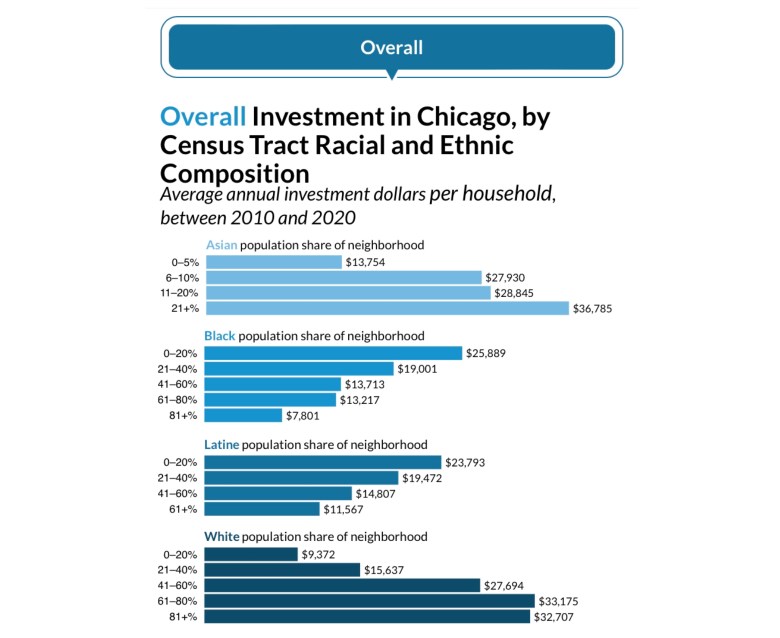Urban Institute’s public and private investment analysis found that access to a relatively healthy stream of capital is not spread equally across Chicago neighborhoods.
The nonprofit research organization analyzed investment trends from 2010 to 2020 and found that the larger the share of Black residents in a neighborhood, the less investment occurred. For example, over the decade, areas with more than 80 percent Black residents received just 37 percent as much per-household investment as neighborhoods with fewer than 20 percent Black residents. The connection between race and investment also held for Latino neighborhoods, although to a lesser extent, the study found.
Researchers said that “by better understanding these patterns and inequities, local leaders can focus their efforts on creating more economic opportunity for all Chicago residents.”
The study also found that investment also varies among Chicago neighborhoods with different poverty levels “Because of historical and current systemic racism and discriminatory practices around property appraisal, sales, purchase, and lending, neighborhoods with large shares of people of color are often also neighborhoods with large shares of people experiencing poverty,” researchers said.
SUGGESTION: Racial Bias In Home Appraisals

On average, the lowest-poverty neighborhoods receive 3.6 times more single-family lending per household and 1.8 times more multifamily lending per household than the highest-poverty neighborhoods receive.
The racial and income disparities in investment reflect inequities in neighborhood market conditions, wealth levels, credit access, and capacity to absorb capital. But these long-standing trends are not only a result of decades of disinvestment and exclusion but also a cause of continued inequality across neighborhoods.
Researchers suggest strategies to boost investment should include expanding the use of special-purpose vehicles to increase mortgage access; leveraging grants, guarantees, and loss reserves to grow small-business lending; and implementing commercial corridor revitalization strategies to bolster nonresidential investment.
INVEST South/West Initiative
“People talk a lot about public safety, but if you look at the root causes of crime, a lot of it arises from generational poverty,” said Chicago Mayor Lori Lightfoot about the INVEST South/West Initiative, a plan meant to spur development and investment in 10 neighborhoods on the South and West sides. “So creating a set of vibrant communities where young Black boys, in particular, could see themselves in the future of their neighborhood or city that wasn’t preordained to be part of a gang, to be part of illegal activity that was also critically important.”
The community development initiative brings together the resources of multiple City departments, community organizations, and corporate and philanthropic partners toward 12 commercial corridors within 10 South and West Side community areas. Now in its third year, the City has aligned more than $2.2 billion in public and private investment.
“INVEST South/West is ready to expand its reach beyond retail districts to include nearby residential blocks that are vital to sustainable neighborhood growth,” said Lightfoot. “We will soon say goodbye to the pervasive vacant lots across the South and West Sides and say hello to new two-flats, three-flats, and other walk-up structures that have been home to Chicago families for generations.”
Last month, groundbreakings in Austin: the $47 Million Austin United Alliance mixed-use project at 5200 W. Chicago Avenue and an adjacent $26 million streetscape project led by the Chicago Department of Transportation (CDOT) marked INVEST’s anniversary. They are examples of the extensive public and private actions the Urban Institute finds are necessary to create economic opportunity for residents in all of Chicago’s neighborhoods.
Cover Photo by RODNAE Productions.



